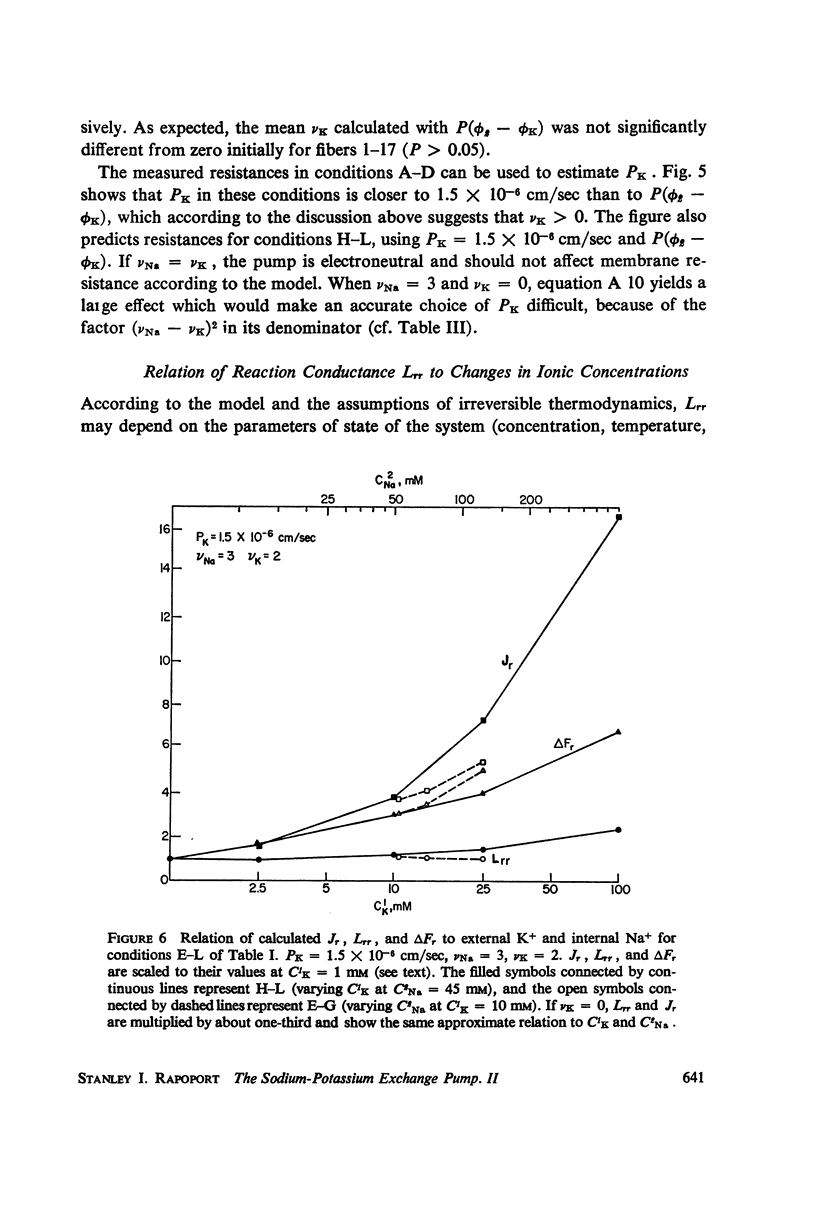Abstract
A model for the Na-K exchange pump was applied to data on Na+-loaded frog sartorius muscle, and was used to relate the rate of adenosine triphosphate (ATP) hydrolysis to the electrical properties of the cell membrane. Membrane hyperpolarization was considered to arise from an electrical current which was produced by the hydrolysis reaction coupled to ion movements, and which flowed across the membrane. The reaction rate, as calculated from hyperpolarization, agreed with direct measurements of ATP hydrolysis and with the rate estimated from Na+ tracer efflux studies. Although Na+ is actively extruded, the model showed that K+ is inwardly transported if the potassium permeability of the membrane is less than about 6.6 × 10-6 cm/sec, as is suggested by resistance data. Calculations indicated that the reaction conductance Lrr was relatively constant when compared with the reaction rate and reaction free energy for large changes in internal and external ionic concentrations. Its value agreed with the value obtained from the dependence of Na+ tracer efflux on external K+. A set of experiments was suggested which would provide a more complete interpretation of the data.
Full text
PDF
















Selected References
These references are in PubMed. This may not be the complete list of references from this article.
- Adrian R. H., Slayman C. L. Membrane potential and conductance during transport of sodium, potassium and rubidium in frog muscle. J Physiol. 1966 Jun;184(4):970–1014. doi: 10.1113/jphysiol.1966.sp007961. [DOI] [PMC free article] [PubMed] [Google Scholar]
- Armstrong W. M. Effect of external potassium and ouabain on sodium efflux from frog sartorius muscle. Proc Soc Exp Biol Med. 1969 Apr;130(4):1264–1270. doi: 10.3181/00379727-130-33769. [DOI] [PubMed] [Google Scholar]
- Beaugé L. A., Sjodin R. A. Transport of caesium in frog muscle. J Physiol. 1968 Jan;194(1):105–123. doi: 10.1113/jphysiol.1968.sp008397. [DOI] [PMC free article] [PubMed] [Google Scholar]
- CONWAY E. J. Critical energy barriers in the excretion of sodium. Nature. 1960 Jul 30;187:394–396. doi: 10.1038/187394a0. [DOI] [PubMed] [Google Scholar]
- Cross S. B., Keynes R. D., Rybová R. The coupling of sodium efflux and potassium influx in frog muscle. J Physiol. 1965 Dec;181(4):865–880. doi: 10.1113/jphysiol.1965.sp007802. [DOI] [PMC free article] [PubMed] [Google Scholar]
- DESMEDT J. E. Electrical activity and intracellular sodium concentration in frog muscle. J Physiol. 1953 Jul;121(1):191–205. doi: 10.1113/jphysiol.1953.sp004940. [DOI] [PMC free article] [PubMed] [Google Scholar]
- FREYGANG W. H., Jr, GOLDSTEIN D. A., HELLAM D. C. THE AFTER-POTENTIAL THAT FOLLOWS TRAINS OF IMPULSES IN FROG MUSCLE FIBERS. J Gen Physiol. 1964 May;47:929–952. doi: 10.1085/jgp.47.5.929. [DOI] [PMC free article] [PubMed] [Google Scholar]
- Frumento A. S. The electrical effects of an ionic pump. J Theor Biol. 1965 Sep;9(2):253–262. doi: 10.1016/0022-5193(65)90111-6. [DOI] [PubMed] [Google Scholar]
- Garrahan P. J., Glynn I. M. The incorporation of inorganic phosphate into adenosine triphosphate by reversal of the sodium pump. J Physiol. 1967 Sep;192(1):237–256. doi: 10.1113/jphysiol.1967.sp008298. [DOI] [PMC free article] [PubMed] [Google Scholar]
- HODGKIN A. L., HOROWICZ P. The influence of potassium and chloride ions on the membrane potential of single muscle fibres. J Physiol. 1959 Oct;148:127–160. doi: 10.1113/jphysiol.1959.sp006278. [DOI] [PMC free article] [PubMed] [Google Scholar]
- Harris E. J. The stoicheiometry of sodium ion movement from frog muscle. J Physiol. 1967 Nov;193(2):455–458. doi: 10.1113/jphysiol.1967.sp008370. [DOI] [PMC free article] [PubMed] [Google Scholar]
- KERNAN R. P. Membrane potential changes during sodium transport in frog sartorius muscle. Nature. 1962 Mar 10;193:986–987. doi: 10.1038/193986a0. [DOI] [PubMed] [Google Scholar]
- KEYNES R. D. The ionic fluxes in frog muscle. Proc R Soc Lond B Biol Sci. 1954 May 27;142(908):359–382. doi: 10.1098/rspb.1954.0030. [DOI] [PubMed] [Google Scholar]
- MULLINS L. J., AWAD M. Z. THE CONTROL OF THE MEMBRANE POTENTIAL OF MUSCLE FIBERS BY THE SODIUM PUMP. J Gen Physiol. 1965 May;48:761–775. doi: 10.1085/jgp.48.5.761. [DOI] [PMC free article] [PubMed] [Google Scholar]
- MULLINS L. J., FRUMENTO A. S. The concentration dependence of sodium efflux from muscle. J Gen Physiol. 1963 Mar;46:629–654. doi: 10.1085/jgp.46.4.629. [DOI] [PMC free article] [PubMed] [Google Scholar]
- Martirosov S. M., Mikaelian L. G. Ionnyi obmen pri élektrogennom aktivnom transporte ionov. Biofizika. 1970 Jan-Feb;15(1):104–111. [PubMed] [Google Scholar]
- Mullins L. J., Brinley F. J., Jr Potassium fluxes in dialyzed squid axons. J Gen Physiol. 1969 Jun;53(6):704–740. doi: 10.1085/jgp.53.6.704. [DOI] [PMC free article] [PubMed] [Google Scholar]
- RELMAN A. S., LAMBIE A. T., BURROWS B. A., ROY A. M. Cation accumulation by muscle tissue: the displacement of potassium by rubidium and cesium in the living animal. J Clin Invest. 1957 Aug;36(8):1249–1256. doi: 10.1172/JCI103522. [DOI] [PMC free article] [PubMed] [Google Scholar]
- Rapoport S. I. The sodium-potassium exchange pump: relation of metabolism to electrical properties of the cell. I. Theory. Biophys J. 1970 Mar;10(3):246–259. doi: 10.1016/S0006-3495(70)86297-X. [DOI] [PMC free article] [PubMed] [Google Scholar]
- Sjodin R. A., Beaugé L. A. Strophanthidin-sensitive components of potassium and sodium movements in skeletal muscle as influenced by the internal sodium concentration. J Gen Physiol. 1968 Sep;52(3):389–407. doi: 10.1085/jgp.52.3.389. [DOI] [PMC free article] [PubMed] [Google Scholar]
- Taylor G. S., Paton D. M., Daniel E. E. Characteristics of electrogenic sodium pumping in rat myometrium. J Gen Physiol. 1970 Sep;56(3):360–375. doi: 10.1085/jgp.56.3.360. [DOI] [PMC free article] [PubMed] [Google Scholar]


